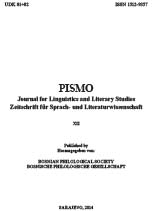Kiplingov Orijent – “Bela foka”
Kipling’s Orient: “The White Seal”
Author(s): Amela Lukač-ZoranićSubject(s): Other Language Literature, Cultural Anthropology / Ethnology, Culture and social structure , Theory of Literature
Published by: Bosansko filološko društvo
Keywords: Kipling; Orient; White seal; the Other; India;
Summary/Abstract: In his “serious” works Kipling glorifies British imperial power, while his works for children contain a distinctive ode to nature and human curiosity. In the case of the former, Kipling uses a series of dichotomies, the first of which is “civilized” versus “wild”: white man in opposition to the indigenous people of India. Being part of civilization automatically provides the white man with a superior character in relation to the painted primitive man, and thus justifies the colonizer’s right to undisputed rule. On this basis, Kipling’s identification and subsequent ascertainment or revision of the identity of the Other (who is little-known and different, for various reasons) comes from the adopted dichotomy of the subaltern versus self-determination of the superior race that colonized India. “The White Seal” is the story in which Kipling’s didactic tendencies are most obvious. In it, he not only condemns the hunters for killing seals for their pelts, but also for creating an ideal hierarchical racist system in the seals’ realm. His solution is a white seal that will lead the others to safe shores where they can live peacefully. From the postcolonial perspective, this story is a symbolic narrative about the value of what is “white”.
Journal: Pismo - Časopis za jezik i književnost
- Issue Year: 2014
- Issue No: 12
- Page Range: 165-174
- Page Count: 10
- Language: Bosnian

